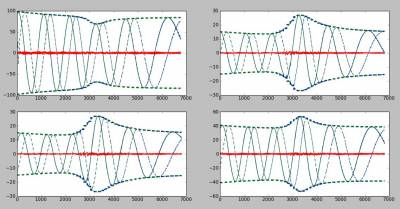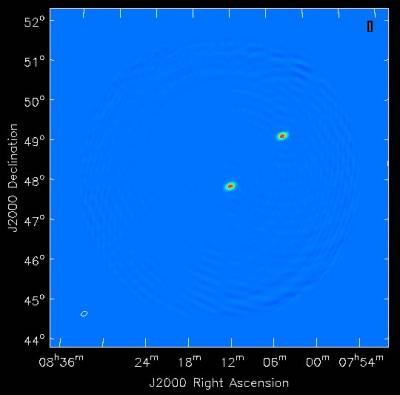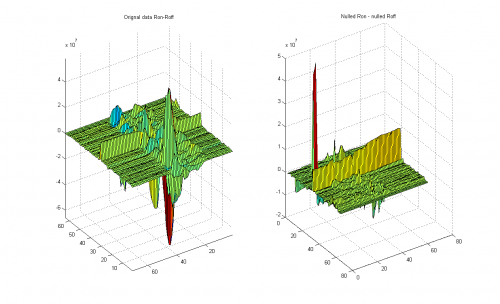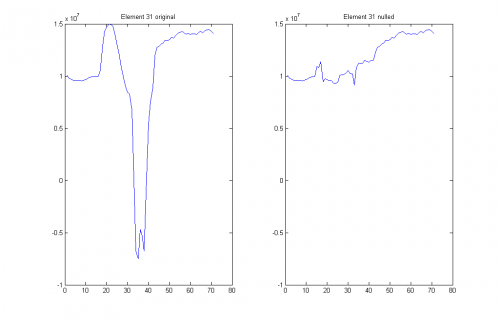You are here: start » na » reporting » wp_6_period_8
ALBIUS: Achievements in reporting period: 2011 Q2
ASTRON:
Oleg Smirnov published another paper on Calibration and Direction dependent effects 16764.pdf
The work on correcting for direction dependent effects focused on the implementation of A-projection for time variable, fully polarized beams in CASA. A first implementation was delivered. Initial testing on simulated data showed good results. Now further testing is needed and the performance of the code should be investigated on real data. Testing so far has been on LOFAR primary beams, but the code is set up in such a way that also other primary beams like for ALMA and EVLA can be added. The LOFAR Primary Beam can be seen as the union of EVLA, ALMA, and MeerKAT primary beams. Investigation of the underlying measurement equation showed that ionospheric direction dependent effects can be corrected in a similar fashion as primary beams. Implementation of ionospheric correction, however, falls outside the scope of this ALBiUS task.
 Figure 1: Comparison of BBS DFT Predict against AWProjection de-gridding for the four correlations XX, XY, YX, and YY.
Figure 1: Comparison of BBS DFT Predict against AWProjection de-gridding for the four correlations XX, XY, YX, and YY.
 Figure 2: Two simulated point sources are recovered to within 1% in all four polarizations.
Figure 2: Two simulated point sources are recovered to within 1% in all four polarizations.
JIVE:
Work on the Fringe Fitting project at Jive has concentrated on two areas:
1) continued development on the Casa implementation;
2) development of Python software for research and development to facilitate experimenting and testing of ideas before incorporation into the Casa implementation.
The Casa implementation of a baseline based Delay, Rate solver has been optimized to speeding up the FFT stage of the existing implementation. Work is currently concentration on incorporating the baseline stacking code into Casa. The goal is to implement it independent of the fringe fitting code so it can also be used elsewhere in Casa.
The above mentioned Python software simulates data with user specified delay and rate properties. And provides a platform for testing solver algorithms. It has been used to experiment with using Casacore's solvers in the baseline based solver for increased accuracy and speed. The effects of dispersive delays are also been studied with this software to develop a strategy for the application of Fringe Fitting to wide band data. VLBI instruments around the world are currently undergoing bandwidth upgrades. Wide band delay calibration may also be useful for the instruments in current commissioning and development.
NRAO:
This cycle most of the effort on wide-band and wide-field imaging was spent on the work to build the generic framework for full Mueller matrix treatment during imaging. The framework will ultimately be used to implement a number of special cases required for EVLA, ALMA and LOFAR. This includes wide-band AW-Projection and A-Projection with heterogeneous array support (required for ALMA and LOFAR). In a collaborative effort with the LOFAR team, full polarization AW-Projection using a time-variable model for the LOFAR station beams was demonstrated to work as expected. This has now been incorporated in a LOFAR imager. Work to integrate the wide-band imaging algorithms in this framework is in progress.
High performance computing and parallelization continue to advance, the upcoming release of CASA will contain the first implementation of these algorithms in production CASA code for end users. Several of the most time consuming data calibration and editing steps are now performed in parallel. In addition both spectral line and continuum imaging can now be performed in parallel. Several bottlenecks in the parallel processing of data have been identified and removed. We expect to continue to improve the performance and capabilities of the parallel processing through the next quarter, and look forward to feedback from the public use of these facilities.
NRAO's roles in the ALBiUS Advanced Fringe Fitting effort are largely organizational and supervisory. We organize a bi-weekly telecon, provide technical advice and help with the integration of the new code into CASA. Our effort between April 1 and June 30 2011 has been focused on getting the first bits of code into CASA by the mid September code freeze. A next quarter milestone will be completing this.
Note: There may be simulated images with and without AW-Projection in full polarization that can be included, but the LOFAR folks might include it in their side of the ALBIUS report. Sanjay has written to them but it may be too late to get them now.
UCAM:
Dr. Sam George was appointed as a replacement for Joern Geisbuesch and started work on 1 June 2011.
Accurate measurements of instrumental polarization and correction of polarization cross-talk between the components of the Stokes vector is critical to the science of polarimetry. Measuring the Stokes vector resulting form the instrument, we can retrieve the Muller matrix using a non-linear-least-squared fit based on the known fractional form of the matrix of the calibration optics assuming a static instrument Muller matrix. Good polarization calibration must deliver both the instrumental polarization and the position angle calibration. An unpolarized source allows one to determining the instrumental polarization and does not require parallactic angle coverage. A polarized source can only give the position angle calibration and the polarization needs to be known a priori. Sources with unknown polarization need sufficient parallactic angle coverage.
Generally the instrumental polarization is solved using a linear approximation where the cross-terms in more than a single product of the instrumental or source polarization are ignored in the measurement equation. This is not a sufficient approach for data where there is high (of order a few percent) instrumental polarization leakage, for this we need a generalised non-linearised solution. This is of course, important for high dynamic range wide field total intensity imaging.
The current implementation in Common Astronomy Software Applications package (CASA) uses the small amplitude approximation. Though this works fairly well on observations with small leakage terms the residual leakage is still seen in the maps produced. We are implementing a non-linear method that removes this restriction. In python (using CASA to access the measurement set) we have implemented a task which extracts the useful data from the measurement set efficiently. The observations of a known unpolarized source is then used as a model of the leakage and this signal is removed on a channel by channel basis whilst making the assumption that this is non-time varying. This has been applied to both test data and 610~MHz Giant Metrewave Radio Telescope (GMRT) data. The calibration returned gives a similar scatter to that obtained via CASA's `polcal' task. An improved method of solving the full instrumental Muller matrix is being implemented. Currently, the routine does a fit to the data and returns the Muller matrix per channel, though at the moment when the inverse is applied to the data the results are disappointing.
A new set of plotting tools have also been developed inside of CASA using matplotlib - these allow for quick visualisation of the polarization calibration data. For example, these animated plotting of Stokes Q,U as a function of time for all channels, plotting Q/I vs U/I for all times as a function of channel and antenna, showing a given number of antennas.
Manchester:
Beswick and Muxlow, working with graduate student Nick Wrigley, have been working to chararacterise the primary beam response of individual telescopes and their combinination to create interferometric primary beam response for inhomgeneous telescope arrays. Nick's preliminary report is here.
Richards has developed ready-reckoners for data averaging in time and frequency, i.e. how much can one reduce the size of data sets for continuum imaging without excessive bandwidth or time smearing, and also spectral index, phase rate and dynamic range effects, as a function of the desired field of view. A summary and examples for ALMA and e-MERLIN were presented at CALIM, see http://www2.skatelescope.org/indico/materialDisplay.py?contribId=11&sessionId=13&materialId=0&confId=171 Suitable scripts can be provided (for any array meeting the assumptions e.g. dishes) and eventually options might be provided for SPLIT in CASA.
Richards has been testing wide field imaging tasks (among others) incorporated in CASA, in liaison with Urvashi Rau, and provided feedback on requirements to Stephen Bourke and Ian Stewart re fring-like task.
ESO:
Dirk Petry wrote a number of reports about CASA tests.
As recent measurements on real ALMA antennas have shown that astigmatism is an important additional parameter to include in the simulations we looked for a way of including this in the responses. In addition to the ALMA response images (obtained from TICRA), which can not be modified easily, a new simulation path was opened up for ALMA antennas within CASA using code provided by Walter Brisken (NRAO) which was already used before for the EVLA.
The code by W. Brisken had previously been pasted into CASA in a non-object-oriented way and parameters were hard-wired. When DP started work on this in order to enable the sharing of the code between EVLA and ALMA analysis routines and to permit setting of the parameters without recompiling CASA, the first step was to extend the previously developed unified access scheme (“AntennaResponses”) to permit the setting of the parameters through user-modifiable text files. Default versions of these parameter files are distributed with CASA.
The EVLA parameters were then translated into this new representation and the code was extensively tested with EVLA data.
The ALMA parameters were derived from the technical documentation of the four antenna types (the three 12m types and the one 7m type) and also entered into the new parameter files
A parameter for controlling the astigmatism of each antenna was foreseen. Furthermore, the ray tracing code by W. Brisken was cast into a proper class with a singleton interface to the rest of the code.
With Sanjay Bhatnagar from NRAO, the ALMAAperture class for using the antenna response patterns to correct for direction dependent effects in imaging was further designed and implemented. Tests are still ongoing and unfortunately somewhat delayed since Sanjay is also working on other projects.
ALMA test data was obtained and is ready for when Sanjay has finalised his part of the code which will hopefully happen later this year.
The new parameter format and the extended AntennaResponses scheme will be part of the next CASA release (3.3).
Bordeaux
Goal of astrometry subtask is to combine group delays and phase delays for astrometric applications. This includes devising new observing strategies. The MODEST software package is used for this purpose. The Bordeaux observatory has implemented and tested procedures to simulate phase delays with MODEST. Discussions about the issues in simulating such data sets have been carried out with JPL. Finally, initial tests combining group delays and phase delays have been performed.
MPIfR:
Working documents can be found here: http://www.radionet-eu.org/fp7wiki/doku.php?id=jra:albius:processing
VN OH observation of Cyg A, NGC 1068 (E10C014) for RFI mitigation test.
Correlation was completed!
Correlator: Bonn DiFX 2 correlator extended with multi-rate filter for RFI mitigation.
Multi-rate filter topology: Arbitrary configurable chain of different filter types
Filters implemented: Decimator block, IIR SOS biquad filter block (efficient lowpass), DSVF digital state variable filter block (most efficient lowpass), Integrator block, Moving average block.
Two correlation passes: one with RFI mitigation filter switched on, one with filter switched off.
Calibration is advanced: Cyg A data have been calibrated in AIPS and first cube produced. Continuum image is good. Spectral baselines need still some improvement to look for OH absorption.
Next: Can begin comparing spectra with and without RFI mitigation to validate mitigation effectiveness.
Focal Plane Array RFI mitigation:
Added specification to APERTIF beamformer design for Effelsberg for the formation of cross-correlations between elements to enable use of eigen decomposition methods. G. Knittel (MPIfR) has implemented cross-correlation computation in his Effelsberg APERTIF demo beamformer.
Developed Beamformer C++ library. Partially under work. Library uses LAPACK/ATLAS via Armadillo C++ (Linux, Windows) for fast matrix computation. Currently in DiFX SVN repository. To be uploaded onto project wiki.
Implemented in Matlab: several RFI cancellation algorithms, RFI detection, two FPA model generators, UV gridder, various testing code.
Implemented in final C++ library: decompositions, RFI detection, nulling, subtraction algorithms. Included in DiFX SVN due to great potential for DiFX phase array processing.
Algorithm 1: Post-correlation adaptive filter using eigen-decomposition of the covariance matrix (for example Briggs & Kocz)
Algorithm 2: Post-correlation RFI templating and subtraction using covariance matrix with one or more elements being RFI reference antennas (for example Kesteven, Briggs or van der Veen)
Test Data: Synthetic data with and without reference antennas generated for controlled testing of the algorithms, and Westerbork APERTIF correlation matrices from Wim van Capellen.
Results on synthetic data: The implemented subspace nulling (Matlab, C++) is highly effective in cancelling interferers in the data models (> 60 dB). The implemented subtraction (Matlab, C++) is equally effective for the data models, within certain constraints on the number of available reference antennas in practice and the maximum number of interferers.
Results on Virgo A (APERTIF data): Strong RFI at 1490 MHz from Afristar can be suppressed enough that the source (Virgo A) can then be seen in the central beam. Cancellation is reasonably good but not as excellent as seen in the synthetic test data nor as good as demonstrated by Briggs & Kocz (2005), probably since they used reference antennas to get good interference-to-noise ratio on the interferer, which is not available in the APERTIF data.
 Figure 1: 3D surface plot of APERTIF element autocorrelation power spectra before (left) and after (right) RFI mitigation, showing that the source (Virgo A) becomes visible after RFI mitigation. Axis 1 sloping 45 degrees upwards towards left: APERTIF array element number. Axis 2 sloping 45 degrees upwards towards right: frequency channel (1 to 72 = 1483.0 MHz to 1496.7 MHz spaced 195.3125 kHz) Axis 3 vertical: power difference between on-source and off-source pointings. Strong RFI is present from Afristar at 1490 MHz, visible before mitigation as the rumble through the middle of the spectrum in all elements (blue-green maxima sloping upwards to the left). After mitigation the rumble of RFI is much reduced, and the source (Virgo A) is visible in array element 31 (orange ridge sloping upwards to the right). A strong peak becomes visible in element 11 channel 17 (1486.2 MHz) after mitigation, it is present in the mitigated off-source spectrum and not in the mitigated on-source spectrum. Its origin is presently unclear, and might be an algorithm artefact.
Figure 1: 3D surface plot of APERTIF element autocorrelation power spectra before (left) and after (right) RFI mitigation, showing that the source (Virgo A) becomes visible after RFI mitigation. Axis 1 sloping 45 degrees upwards towards left: APERTIF array element number. Axis 2 sloping 45 degrees upwards towards right: frequency channel (1 to 72 = 1483.0 MHz to 1496.7 MHz spaced 195.3125 kHz) Axis 3 vertical: power difference between on-source and off-source pointings. Strong RFI is present from Afristar at 1490 MHz, visible before mitigation as the rumble through the middle of the spectrum in all elements (blue-green maxima sloping upwards to the left). After mitigation the rumble of RFI is much reduced, and the source (Virgo A) is visible in array element 31 (orange ridge sloping upwards to the right). A strong peak becomes visible in element 11 channel 17 (1486.2 MHz) after mitigation, it is present in the mitigated off-source spectrum and not in the mitigated on-source spectrum. Its origin is presently unclear, and might be an algorithm artefact.
 Figure 2: Total power spectra for the central APERTIF element (number 31), differenced between on-source and off-source, before and after RFI mitigation (left and right respectively). The source is Virgo A. Horizontal axis is frequency channel (1 to 72 = 1483.0 MHz to 1496.7 MHz spaced 195.3125 kHz), vertical axis is power difference. RFI from Afristar at 1490 MHz is visible in the centre of the spectrum. The RFI is mitigated quite well in the right hand spectrum. The remaining sinusoidal spectral baseline is due to known standing wave in the Westerbork dish.
Figure 2: Total power spectra for the central APERTIF element (number 31), differenced between on-source and off-source, before and after RFI mitigation (left and right respectively). The source is Virgo A. Horizontal axis is frequency channel (1 to 72 = 1483.0 MHz to 1496.7 MHz spaced 195.3125 kHz), vertical axis is power difference. RFI from Afristar at 1490 MHz is visible in the centre of the spectrum. The RFI is mitigated quite well in the right hand spectrum. The remaining sinusoidal spectral baseline is due to known standing wave in the Westerbork dish.
Remaining issues:
- Why is quality of mitigation limited? Need reference antenna?
- Too many interferers? Source not seen by other elements hence UV gridding fails?
- Can we deal with spectral baseline? (should be correlated between elements)
- DiFX has beamformer mode for use with focal-plane arrays and phase arrays, could in principle integrate calls to the C++ Beamformer library there, such as enabling Nulling or beamformer adaptive weight updates.
- List of activities organised during reporting period
NRAO and JIVE: Fortnightly telecon about Fringe Fitting. Every month 2 meetings one for developers and the second one developers and management.
- Meetings attended – both meetings for NA organisation or meetings on behalf of RadioNet
ASTRON: In May Ger van Diepen travelled to NRAO in Socorro to work with Sanjay Bhatnagar on the implementation of AWProjection for LOFAR Primary Beams in CASA.
JIVE: Stephen Bourke attended CALIM 2011 - Calibration & Imaging workshop. 25-29 July 2011, Manchester, UK
ESO: Petry met with Sanjay Bhatnagar at Socorro in May 2011. He also attended the Calibration and Imaging Workshop in Manchester.
ESO and Manchester: Petry has worked with the e-MERLIN people (Harrison and Richards) on measuring e-MERLIN beam patterns, and on getting e-MERLIN coordinates incorporated and testing their use in coordinate transform tasks in CASA.
Manchester: Anita Richards attended CALIM 2011 - Calibration & Imaging workshop. 25-29 July 2011, Manchester, UK
Problems / Issues
- Issues - organisational, administrative or other problems foreseen
- Red flags - major problems
ESO: Future progress depends on the outside contribution of Sanjay Bathnagar. The delay is partially caused by the attempt to promote the whole algorithm to cover full polarisation. This will, once it works, an advantage also for ALMA, but it is not a high priority. Getting A-projection working for the parallel hands is more important.
Bordeaux: Generating simulated phase delays took more time than originally anticipated due to problems with software/data formats. Due to this delay, the work will probably not be finished by 31/12/2011. Plan is to continue the work up to 15/04/2012 since we have funding for the project until then (and RadioNet JRAs have been extended until 30/06/2012). Bordeaux urgently needs an official statement indicating that RadioNet is extended until 30 June 2012 to comply with a request of the University of Bordeaux.
Forward Look
ESO: In 3 months an improved version of the ALMA Antenna Responses will be in the release branch of CASA and will go out with the 3.3 release in October. After that there will be some tests.
ASTRON: The AWProjection implementation will be further tested. Final reports for the ALBiUS tasks will be written.
Manchester: For the primary beams corrections, Manchester will continue to test this in AIPS, including for eMERLIN data with Lovell.
The next steps include work with Harrison, who will be measuring the beam
responses for several of the eMERLIN telescopes. This can be incorporated
into Wrigley's work. We will also look at how this can be made compatible
with the CASA facilities for incorporating beam voltage patterns and
weighting.
Bordeaux: Continuing the tests for the combination of group delay and phase delay data sets. Then test the observing strategies taking advantage of the two data sets. 9.5 additional man-months to be spent on the project from 01/07/2011 to 15/04/2012.
- * Expected milestones/deliverables
UCAM: Deliverable #1: Improved CASA polarization calibration routine and associated plot tools Completion date: October 2011
Having completed this first deliverable we will develop the work to concentrate on the wide-field aspects Man months in this period: 3 month (SG) 0.1 month (PA) 0.2 month (DF)
ESO: Report on mosaic software (Dec 2011)
MPIfR: Delivery of all deliverables is expected by end of 2011.
Financial Report *
By Excel Sheet